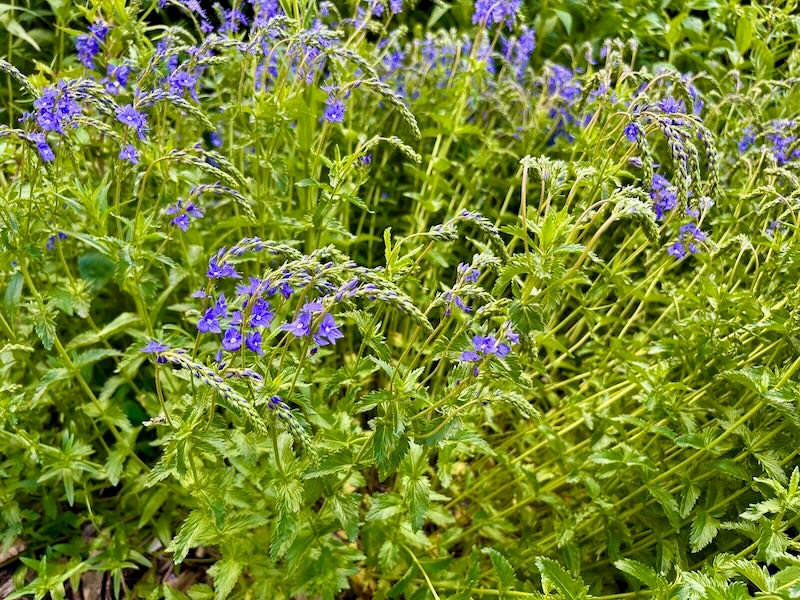Veronica austriaca ssp. teucrium: A Brilliant Blue for Sunny Borders
Veronica austriaca ssp. teucrium, commonly known as Broad-leaved Speedwell, Large Speedwell, Austrian Speedwell, or Saw-leaved Speedwell or Hungarian speedwell, is a vibrant perennial celebrated for its rich blue flower spikes and tidy, clump-forming habit. Belonging to the plantain family Plantaginaceae, this subspecies brings both structure and color to garden borders, rock gardens, and naturalistic plantings. Native to Europe and parts of eastern Asia, it thrives in well-drained soil and sun-drenched sites, rewarding gardeners with its striking summer display.
Characteristics and Description
This herbaceous perennial reaches 60 cm (about 24 in) tall and spreads to nearly the same width. The foliage forms a neat mound of hairy, oblong, toothed leaves that resemble those of Teucrium, the germander genus—hence the subspecies name. From late spring into early summer, the plant produces dense, upright racemes of small, outward-facing, saucer-shaped flowers in brilliant blue. These blooms create a vivid splash of color just when many spring bulbs have faded and before summer perennials reach full swing.
Veronica austriaca ssp. teucrium grows to its mature height and spread (0.5 to 1 meter) within two to five years. Its compact form and long flowering season make it an excellent choice for mass planting or edging mixed borders. Popular cultivars like ‘Crater Lake Blue’ and ‘Royal Blue’ have even earned the Royal Horticultural Society’s Award of Garden Merit.
How to Grow Veronica austriaca ssp. teucrium
Light
This plant flourishes in full sun but can tolerate partial shade, especially in hotter regions. For best flowering, choose a spot with at least six hours of direct sunlight per day.
Soil
Well-drained, loamy soil is ideal. It can grow in average garden soil, but adding compost or other organic matter improves soil structure and boosts performance. Avoid heavy clay or consistently wet ground, which may lead to root rot.
Watering
Once established, Veronica austriaca ssp. teucrium tolerates short dry spells, though it performs best with regular moisture. Water deeply during prolonged dry periods, especially when the plant is in bloom. Avoid overwatering and soggy conditions.
Fertilizing
This perennial doesn’t require heavy feeding. A single application of a balanced, slow-release fertilizer in spring is usually sufficient. Over-fertilizing can result in lanky growth and fewer flowers.
Pruning
Deadheading spent flower spikes can encourage additional blooms and prevent self-seeding. In late autumn or early spring, cut back the entire plant to the base to tidy up the clump and promote fresh growth.
Dividing
Divide mature clumps every three to four years in spring or early fall. Division not only revitalizes growth but also allows propagation and helps prevent overcrowding.
Pests and Diseases
Veronica austriaca ssp. teucrium is generally resistant to deer and rabbits, making it a reliable choice for wildlife-prone gardens. It attracts bees and other pollinators, contributing to biodiversity. While the plant is relatively pest-free, it can occasionally encounter powdery mildew, especially in humid or shaded locations. Good air circulation, well-draining soil, and proper spacing help prevent disease.
Hardiness and Garden Use
Hardy in USDA zones 3 through 11, this perennial adapts well to a wide range of climates. Its tidy habit and vivid blue blooms make it an excellent addition to:
- Rock gardens
- Mixed perennial borders
- Pollinator gardens
- Slopes or hillside plantings
- Cottage-style gardens
With its bright summer color, manageable size, and easygoing nature, Veronica austriaca ssp. teucrium is an ideal choice for gardeners seeking beauty with minimal fuss. Whether used as a front-of-border plant or interplanted among ornamental grasses and drought-tolerant companions, it brings cheerful energy and long-lasting appeal to sunny garden spaces.
Botanical Background
The genus Veronica contains more than 500 species of flowering plants, many of which are valued in ornamental horticulture. Within this diverse group, Veronica austriaca and its subspecies are known for their resilience and adaptable beauty. The species name austriaca points to its presence in Austria and surrounding regions, while the subspecies teucrium alludes to the leaf similarity with Teucrium species.
Veronica austriaca ssp. teucrium represents the best of this genus—charming, tough, and vividly colored. It’s a must-have perennial for gardeners who crave dependable color and graceful structure throughout the growing season.



